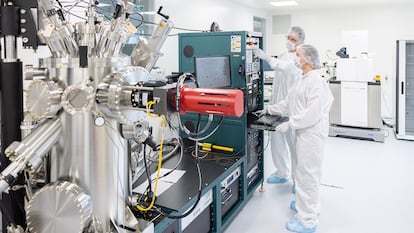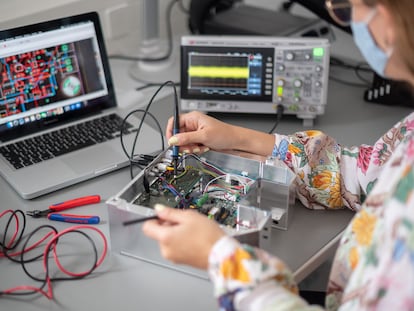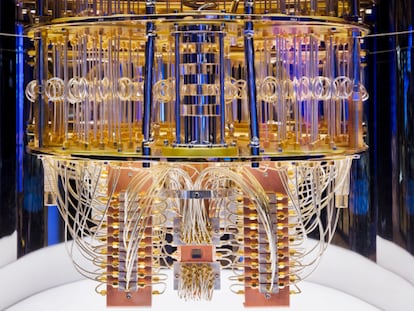‘We have made science fiction come true!’ Scientists prove particles in a quantum system can be rejuvenated
An Austrian and Spanish team demonstrated that a process can be ‘rewound’ to restore the components of an atom to their previous state

Imagine you are 40-something and want to go on a date looking like you did 20 years ago. This is impossible in the classical physical world but not in the quantum world, which refers to the subatomic particles that are the foundation for all reality. Miguel Navascués and David Trillo, Spanish researchers from the Institute of Quantum Optics and Quantum Information (IQOQI) of the Austrian Academy of Sciences (ÖAW), conducted several studies with Austrian researcher Philip Walther and the University of Vienna’s experimental physics group. The team published papers in Physical Review X, Quantum, Arxiv, Physical Review Letters and Optica on theoretical research and experiments proving it’s possible to “accelerate, decelerate and reverse the flow of time within arbitrary, even uncontrolled quantum systems.” These unique physical processes, capable of disrupting the normal course of time, are universal: they have the same effect on all particles, regardless of their nature and interaction with other systems.
Everything we perceive responds to the fundamental laws of physics we learn in school. Yet, quantum physics researchers agree that they do not explain the subatomic world, which shapes all reality at its most microscopic levels. This invisible universe presents instances of superposition (a particle can be in one state, in another or in both simultaneously), entanglement (the action on one particle instantaneously affects the other, even if they are separated by great distances), pseudo-telepathy and teleportation.
This team of scientists has now demonstrated that these quantum particles can be rejuvenated or reverted to a previous state. Miguel Navascués uses an analogy to explain the significance of the finding and how they proved it. “In a theater, [classical physics], a movie is projected from beginning to end, regardless of what the audience wants. But at home [the quantum world], we have a remote control to manipulate the movie. We can rewind to a previous scene or skip several scenes ahead.”
The ÖAW team developed a “rewind protocol” that enables any particle (electron, proton or muon) to revert to a previous state. Trillo led the way in proving this capacity theoretically and experimentally using a photon that evolves when it passes through a crystal. The creative use of an experimental device known as a “quantum switch” allows the light particle to return to its state at the beginning of its journey.
“It was one of the most difficult experiments we’ve ever built for a single photon,” said Walther. “The fascinating thing is that [the particles] can return to a state you know nothing about.” In other words, said the scientists, “you can run it without knowing about the system, its internal dynamics, or even the details of the interaction between the system and the experimenter.”
According to Navascués, the experiment is based on a century-old approach to Einstein’s theory of relativity. “A twin travels into space at high speed while his sibling remains on Earth. When the space traveler returns, he or she will have aged less than the one who stayed home. The traveler can claim that the trip into space took less time than the one measured on Earth.” Although observable, this relativistic phenomenon “is impractical because enormous amounts of energy or proximity to a black hole are needed to observe significant effects. It is also limited in that it can slow down time, but not reverse or accelerate it.” But the team wanted to demonstrate that “these limitations disappear when one leaves the realm of classical relativistic physics and enters the realm of non-relativistic quantum mechanics.”
They claim to have done just that. “We present a universal mechanism that, when it acts on any qubit, propagates it to the state it was in before the experiment began.” Unlike the protocols previously discovered by the group, which only work at a certain probability level, the new mechanism is always successful, except when the experimental device is completely “invisible” to the qubit. “We answered the question of whether such processes are allowed by the laws of quantum mechanics,” they said.
Can the experience be transferred to larger systems? The experiment was successfully conducted with particles that can store one bit of information. While it’s theoretically possible to replicate the experience with a human, it is a practical impossibility and useless. “If we could lock a person in a box with zero external influences, it would be theoretically possible. But with our currently available protocols, the probability of success would be very, very low. Also, the time needed to complete the process depends on the amount of information the system can store. A human being is a physical system that contains an enormous amount of information. It would take millions of years to rejuvenate a person for less than a second, so it doesn’t make sense.”
The finding is not a time machine. Time passes regardless, and it is the physical state that changes. “If you want to revert a particle capable of storing one bit of information to its state five minutes ago, that’s the amount of time needed to complete the process,” said Navascués.
The same principle applies to aging a particle – fast-forwarding it to another state in the future. Navascués said, “If you want a system to age 10 years, it will take 10 years. You can’t create time out of nothing. To make a system age 10 years in one year, you must get the other nine years from somewhere.” Using this logic, the scientific team hit upon a trick to speed up time. “We discovered that you can transfer evolutionary time between identical physical systems. In a year-long experiment with 10 systems, you can steal one year from each of the first nine systems and give them all to the tenth. At the end of the year, the tenth system will have aged 10 years; the other nine will remain the same as when the experiment began.”
This finding is significant because it adds one more wrinkle to the quantum world upon which our understanding of the universe depends. But Philip Walther believes it also has practical implications. “We are convinced that it has technological applications. For example, a rewind protocol in quantum processors can be used to reverse unwanted errors or developments.” His colleagues added, “Further research could include non-optical implementations of the protocol and extensions to higher dimensions.”
Navascués doubts the practical utility of the discovery but still considers their research an unprecedented success. “We have made science fiction come true!”
Sign up for our weekly newsletter to get more English-language news coverage from EL PAÍS USA Edition










































